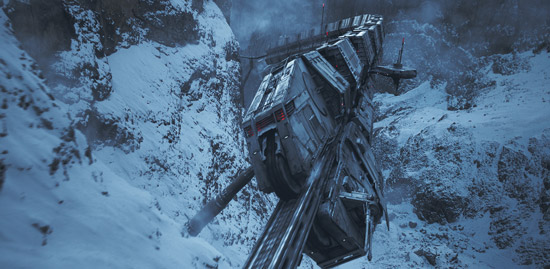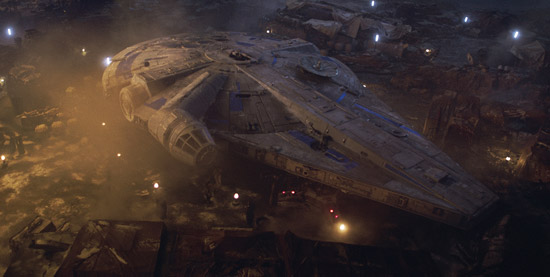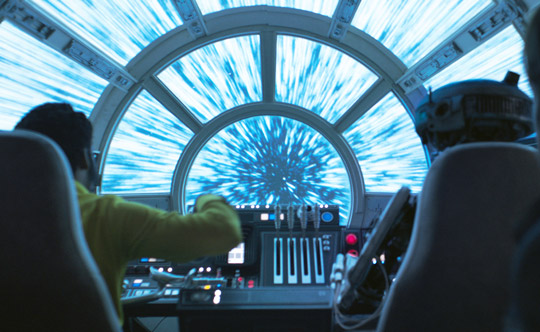INTERVIEW - November, 2018
Magical ~ Industrial Light & Magic
FastForward goes behind the scenes at ILM in San Francisco, where monsters, dinosaurs, and Star Wars come to life through visual effects.
WRITERS/REPORTERS: Kyan Baker, Jack Calloway, Nathaniel Eves, Kylar Flynn, Eliza Gould, Ella Hyman, Lydia Kitzel, Sammi Dostart-Meers, Jane Merkle, Berta Muza, Lilah Richman, Kylie Sebastian, Eve Sloan, Zadie Winthrop FROM: International High School, Marin Academy, Marin Catholic, Marin School of the Arts, Redwood High, San Domenico, San Rafael High, St. Ignatius Preparatory, Terra Linda High, The Menlo School, Urban School of San Francisco
Board the Millennium Falcon and journey to a galaxy far, far away as Rob Bredow, Executive Creative Director and Head of ILM, discusses his latest venture as Co-Producer and Visual Effects Supervisor of Solo: A Star Wars Story.
Bredow has been building and earning his reputation as a topflight visual effects expert since he was a teenager. He entered the film business while still in high school and worked at Sony Pictures Imageworks as Chief Technology Officer and Visual Effects Supervisor before joining Industrial Light & Magic (ILM) in 2014 as Vice President of New Media and Head of Lucasfilm’s Advanced Development Group. Besides Solo his credits include Independence Day, Stuart Little, Anger Management and Cloudy with a Chance of Meatballs.
Throughout his journey into that otherworld known as the movie industry he’s encountered fascinating challenges, life-changing moments and a movie icon or two. He recently took time out of his busy schedule to share some of his experiences with FastForward.
THE INTERVIEW:
FastForward: What was your role in the making of Solo?
Rob Bredow (Director): I was the Visual Effects Supervisor on the film and got to work closely with Ron Howard from beginning to end.
FF: What was the most difficult scene to shoot?
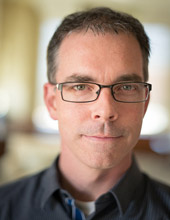 RB: There were two that were the hardest, the train heist and the Kessel Run sequence. Of the two, the most difficult was creating the big monster at the end of the Kessel Run, which was a late addition by Ron Howard. When we started this movie, there were two different directors involved. There were some creative differences, and then it was announced that Ron Howard was coming on to direct. Very exciting, as Ron Howard is an amazing director. He’s directed almost 40 films! So when he came on he looked at everything we’d done and he liked the Kessel Run but felt like it needed to be a little more “alien,” a little more spectacular. In the pre-production phase (before Howard joined the film) we had actually pitched the idea of having a giant space monster in the Kessel Run. Ron liked the idea, so we revived all of our monster ideas and did some quick designs, and that’s when we added the space monster to the movie. Oftentimes on these films you would put green screen out the window and add the visual effects later. On this film we used a rear-projection screen and put these high-resolution projectors behind it so we could project media onto a wall. We did all the visual-effects work in advance. So for the whole Kessel Run, we had already done all the graphics and the visual effects before the actors got in the cockpit. All those shots were ready to go in-camera so they would all be real on set. This was before we knew what Ron was thinking. Then, like the day before we were going to shoot it, he suggested we add the monster. At that point, there was no way to change the media. So what you see in the movie is a combination of the real stuff that we’d projected on the walls, that’s all stuff we captured in the camera, meaning it was really there, plus little green patches where we were going to put in the monster, because we had to figure all that out later. That was definitely one of the hardest things, but it worked out great.
RB: There were two that were the hardest, the train heist and the Kessel Run sequence. Of the two, the most difficult was creating the big monster at the end of the Kessel Run, which was a late addition by Ron Howard. When we started this movie, there were two different directors involved. There were some creative differences, and then it was announced that Ron Howard was coming on to direct. Very exciting, as Ron Howard is an amazing director. He’s directed almost 40 films! So when he came on he looked at everything we’d done and he liked the Kessel Run but felt like it needed to be a little more “alien,” a little more spectacular. In the pre-production phase (before Howard joined the film) we had actually pitched the idea of having a giant space monster in the Kessel Run. Ron liked the idea, so we revived all of our monster ideas and did some quick designs, and that’s when we added the space monster to the movie. Oftentimes on these films you would put green screen out the window and add the visual effects later. On this film we used a rear-projection screen and put these high-resolution projectors behind it so we could project media onto a wall. We did all the visual-effects work in advance. So for the whole Kessel Run, we had already done all the graphics and the visual effects before the actors got in the cockpit. All those shots were ready to go in-camera so they would all be real on set. This was before we knew what Ron was thinking. Then, like the day before we were going to shoot it, he suggested we add the monster. At that point, there was no way to change the media. So what you see in the movie is a combination of the real stuff that we’d projected on the walls, that’s all stuff we captured in the camera, meaning it was really there, plus little green patches where we were going to put in the monster, because we had to figure all that out later. That was definitely one of the hardest things, but it worked out great.
FF: What’s your favorite memory from the set of the movie?
RB: Sitting in the cockpit of the Millennium Falcon was pretty awesome. Also, when we did the wraparound screen we didn’t tell the actors in advance what was going to happen. The first scene was with Phoebe Waller-Bridge, Donald Glover, Emilia Clarke, Alden Ehrenreich and Woody Harrelson. When they walked on the stage, we just had stars on the screen and then we had the cockpit inside. They got in the cockpit and we didn’t tell them what was going to happen next. The special effects people are the ones who move the cockpit around on the hydraulics, so we had conspired. The first time they go into hyperspace we’d shake the cockpit and I’d put hyperspace on the screen and it would be like they’re going on a ride, but we didn’t tell them in advance. We just said buckle up and do your scene. So Alden and Phoebe are sitting in the front seat. The rest of the cast is around the back. They do the first rehearsal with all their lines, then Alden and Phoebe reach over and push the hyperspace lever. When they do that, I trigger the screen and it turns into hyperspace and wraps around, and the whole cast, instead of acting, they just go “Whoa!” And then my favorite moment was when Donald Glover, while everybody was yelling and laughing and giving each other high fives, he says to himself, “This is the coolest thing I have ever done.” I was listening on the headphones—they all wear mics so we can record their voices. That was a pretty fun memory from the set.
FF: Which of the movies you’ve worked on is your favorite?
RB: Solo may be my favorite movie that I’ve worked on. Another favorite was Surf’s Up. The surfing penguins—that was a really fun experience. Working on that movie was a lot like watching the movie. The theme of Surf’s Up is that the journey is the reward and you shouldn’t be too stressed about life. There were two directors on that movie, Ash Brannon and Chris Buck. Chris went on to direct a little movie that probably none of you have ever seen which was called Frozen, and Ash has gone on to direct some amazing movies too. I enjoyed working on that film, really good, talented people.
FF: What are some of the major challenges you’ve faced and how did you overcome them?
RB: The train heist was the other hardest visual-effects sequence in Solo. We knew we had to put these characters on a train that was moving at 60, 70 miles an hour through these mountain regions, and we wanted it to seem as real as possible. Sometimes when you shoot actors on a partial set and you do everything else with visual effects, it can look a little fake, and we didn’t want to have any of that feeling in the movie. So we strategized with the director of photography, Bradford Young, a really talented DP. We looked at lots of movies with scenes like this one and figured out that one of the things that gives away that you’re shooting on a soundstage instead of outdoors is the way the sunlight works. So in that sequence there’s no direct sunlight on anything; it’s pre-dawn. Bradford picked that time of day to try to make it look more real. It’s really hard to make a sun on a soundstage, so we got around the problem by not doing it. Also, if you’ve ever looked at any of Bradford’s photography, he does everything nice and dark and with a really cool, sophisticated look.
FF: Between movies like Surf’s Up and Solo, which kind of movie do you like working on more, animated or live action?
RB: I really like both. I think live-action movies are the most fun in a lot of ways because there’s a kind of a requirement of realism and there’s nothing more fun than actually getting to do stuff for real. Like flying in a real helicopter in the Italian Dolomites to get shots while you’re imaging a train is there, that’s super fun. I really like the live-action visual effects. I did a few years of animated films and I had a lot of fun doing those too.
FF: How has the film industry changed since you started in the business, and how do you foresee it changing in the future?
RB: It’s a lot different now than when I started. When I started, which was 1992, ’91, the question was always, Is it possible to do this? This was before dinosaurs had been done on film [with computers], before Terminator 2. The state of the art in computer graphics was making computer graphics at all, not even making them look photorealistic, so we didn’t know it was going to be possible to do fully realistic characters in the computer at that point. Also computers then were way slower too. For example, this watch is 20,000 times faster and has 100 times more memory than the computer I started with, and that computer cost $120,000. I wear a computer on my wrist that has 16.7 million colors, and I think the computer I started on had a thousand—that’s how much the technology has advanced in 25, 30 years. I think the next big shifts are going to be towards real time. Just like when you’re playing a video game and all those things happen instantly around you at 30 frames a second or 60 frames a second. Artists can make adjustments interactively, and we’re using some of those technologies to change the way we’re making movies now.
FF: At what point in your life did you realize you wanted to become part of the film industry?
I was doing computer graphics even when I was in middle school, but I didn’t realize that people did this as a job until high school. And I remember sitting at a Dodger game… looking at the graphics on the JumboTron… I said, I’ll bet somebody’s getting paid to do those graphics.
RB: I was doing computer graphics even when I was in middle school, but I didn’t realize that people did this as a job until high school. And I remember sitting at a Dodger game in Dodger Stadium and looking at the graphics on the screen, on the JumboTron in the back of the outfield, and I said I’ll bet somebody’s getting paid to do those graphics. I wonder if that’s a full-time job? Maybe I could do that. So, when I took the job-placement tests at my high school, there were no jobs for a computer graphics artist because there just weren’t enough people who were doing it. But once I realized it was a real job, I decided it was a good combination for me. It combines technical skills and artistic skills. And I was really into using computers and I wanted to do something creative. So I got an internship at a company called Vision Art while I was still in high school and that’s where I ended up working for the next 10 years. I worked on movies like Independence Day and Godzilla when I was working there. So just out of high school I landed my first real job, even before I started college.
FF: What’s your favorite part about working in this business?
RB: I like working with creative people. Somebody like Ron Howard is a super-creative person and he’s made a ton of movies and he really knows how to tell stories visually, and there’s nothing better than getting to be in a room with those people who are at the top of their game and pitch an idea and have them like it and want to put it in the movie. That’s pretty fun to be a part of. And here at Industrial Light & Magic we have people who have made some of the most iconic movies. They actually work here, so I get to learn from these highly creative people.
FF: You helped start ILMLAB. Could you tell us about that?
RB: LMxLAB is a combination of what we do in film with storytelling and what we do in video games with gaming technology and real-time graphics, but we do it in a wide variety of immersive experiences. There’s a VOID experience called “Secrets of the Empire” and it’s actually a location you go to. The closest one is at Disneyland in Downtown Disney, but there’s about 10 of them in the world right now, one in London, one in Vegas, various other places. Since this is a virtual reality experience, you put on the headset and you wear a backpack, and your three friends do it as well, and you look at your friend beforehand, they look like you and me, but you put the glasses on and you see a Stormtrooper standing next to you. You’re also disguised as a Stormtrooper and you go on this adventure and you can see walls in virtual reality and you can touch them, real walls! There’s a maze you walk through, and there’s a story that plays out all around you. That’s just one of the experiences we do at xLAB, it’s what we do in digital effects and what we do in real time all combined together.
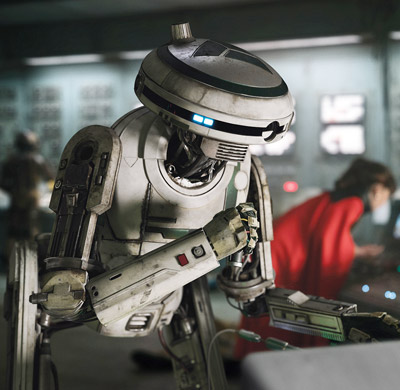 FF: Other than the giant space monster, was there anything that got cut or added last-minute to Solo?
FF: Other than the giant space monster, was there anything that got cut or added last-minute to Solo?
RB: Yes. That speeder chase at the beginning of the movie, Han is actually driving a real speeder, a real car. We custom-built a car that looks like a speeder, with wheels of course, but in visual effects we took out the wheels. And there was Moloch’s car, the big car that’s chasing him. We built a real one of those too. Originally that chase sequence was probably 10 minutes long, which was way too long for the movie, so we kept shortening it and shortening it and now the sequence is about 90 seconds, maybe two minutes in the movie. We had some pretty cool stunts with real cars around this abandoned power plant, those were some fun shots. But something that’s really important in terms of storytelling is that you can make a cool action sequence but nobody really cares unless you care about the characters in that sequence. If we drew the sequence out too much, you wouldn’t be that interested because you didn’t know Han and Qi’ra that well yet. So we used it as a little intro but not a big action sequence because of where it came in the film. That’s one example. There are quite a few others.
FF: Have you ever been really starstruck?
RB: Yes. The first time I was really starstruck was when I was working on The Polar Express. We were in a theater waiting for a screening, and Tom Hanks walked in. We were all talking to each other but when Tom Hanks walked in, all of us stopped talking and just stared at him. He’s actually a super-cool guy and very relaxed about how much attention he gets. But that was one of those times. When Tom Hanks walks in the room, it’s hard not to be impressed. I think that’s happened a couple other times, but usually I try not to get too starstruck.
FF: When you’re doing visual effects for a movie, how involved are you with the actual shooting process?
RB: On movies with a lot of visual effects in them, we’re really involved. Solo was shot in London. I moved to London six months before we started shooting. Originally we were scheduled to shoot for six months but we shot for longer because Ron Howard came on late and we needed to redo some stuff, so I was there for over a year total, and that was all just doing the photography. So I got to sit next to Ron Howard as he was directing to keep an eye out on the visual effects, especially for the big heavy action sequences like the Kessel Run. I got to be pretty involved in that.
FF: What was your favorite thing about working with Ron Howard?
RB: The way he trusts the people who are running the show for him and working for him. He gives them quite a bit of space. I think one of his superpowers is he always has an opinion, he has ideas, but rather than just dictating all the details he tells you what general thing he’s looking for. Like in the case of the space monster, he says “I want something that feels really alien and something that gives you a nice startle moment. That’s what I’m looking for with the space monster.” He didn’t say it has to have two eyes or it has to have six eyes or it has to have 20 tentacles; he said “this is what I need it to do in the story.” So what he does is empower people to be the best version of what their abilities are. Ron provides really clear leadership. He says “Yeah, that’s the idea we’re going to do” or “No, that doesn’t work because of this.” Rather than telling everybody how to do their job, he tells them what he’s looking for. Not all directors do that, so that’s a unique style I really like.
FF: How did you feel when Solo was finished?
RB: It was actually a really great feeling. We finished the movie up at Skywalker Sound on a pretty ambitious schedule. We were doing a Star Wars movie with fewer days in post to do the visual effects than any of those other movies. Fortunately Ron Howard and I and the editor were on the same page. We all had a clear path and there were things we tried that didn’t work but we worked through them pretty quickly and ended up bringing the show in on schedule and at a level of quality that we were all happy with. That felt pretty great. Then I got Ron to tell me stories from when he was a child actor over lunch, and that was super fun too.
FF: What would you say to kids who want to get into filmmaking?
RB: I’d say make films. If you have a phone, you have a more powerful filmmaking device than existed when I was a kid. You have the tools to experiment in your pocket, and you can practice with it, telling stories. You may not know what part of it you’re most interested in. I didn’t know that my specialty was going to be computer graphics, but I got to make a lot of silly short films. Do that and you’ll discover what you really like. You may find that you really like acting or you really like doing the hair and makeup, or any of the other hundreds of filmmaking jobs. The other thing I would recommend is if you’re interested in something and you’re good at it, go after that. It’s super fun, but it’s also a challenging business. We work under really tight deadlines and there’s never enough resources to go around. It’s pretty competitive, a lot of people want to do it. There’s a high bar. We’re always trying to do something new. So if you’re specifically interested in visual effects, fantastic, but make sure you really love it, because it’s a hard business.

